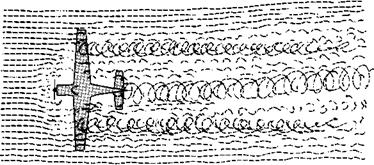Density of the air
Another property of air which is apt to give us misleading ideas when we first begin to study flight is its low density. The air feels thin, it is difficult for us to obtain any grip upon it, and if it has any mass at all we usually consider it as negligible for all practical purposes. Ask anyone who has not studied the question, ‘What is the mass of air in any ordinary room?’ – you will probably receive answers varying from ‘almost nothing’ up to ‘about 5 kilograms.’ Yet the real answer will be nearer 150 kilograms, and in a large hall may be over a metric tonne! Again, most of us who have tried to dive have experienced the sensation of coming down ‘flat’ onto the surface of the water; since then we
|
|
|
|
have treated water with respect, realising that it has substance, that it can exert forces which have to be reckoned with. We have probably had no such experience with air, yet if we ever try we shall find that the opening of a parachute after a long drop will cause just such a jerk as when we encountered the surface of the water. It is, of course, true that the density of air – i. e. the mass per unit volume – is low compared with water (the mass of a cubic metre of air at ground level is roughly 1.226 kg – whereas the mass of a cubic metre of water is a metric tonne, 1000 kg, nearly 800 times as much); yet it is this very property of air – its density – which makes all flight possible, or perhaps we should say airborne flight possible, because this does not apply to rockets. The balloon, the kite, the parachute and the aeroplane – all of them are supported in the air by forces which are entirely dependent on its density; the less the density, the more difficult does flight become; and for all of them flight becomes impossible in a vacuum. So let us realise the fact that, however thin the air may seem to be, it possesses the property of density.













